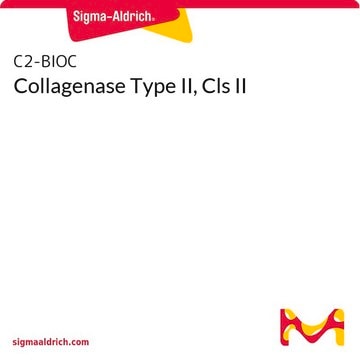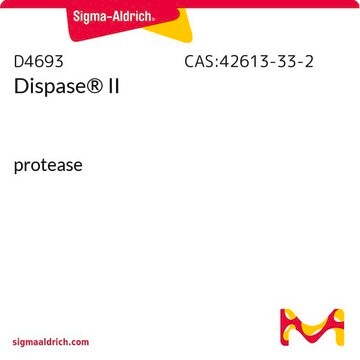The long-term stability of this product in solution has not been determined. However, a similar Collagenase type IV product, C5138, notes that solutions are stable for several months when stored in aliquots at -20°C. Please see the link below to review the datasheet of a similar item:
https://www.sigmaaldrich.com/deepweb/assets/sigmaaldrich/product/documents/380/876/c5138pis.pdf
C4-BIOC
Collagenase Type IV, Cls IV
Synonym(s):
Collagen A, Type IV Gelatinase
About This Item
Recommended Products
Looking for similar products? Visit Product Comparison Guide
General description
Application
- as a component in Dulbecco′s modified Eagle′s medium (DMEM)/F12 to digest endometrial samples isolated from in vitro fertilization (IVF) patients[2]
- for collagenase perfusion to isolate hepatocytes using collagenase-liver perfusion method in rats[3]
- in the isolation of rat glomerular endothelial cells (GEndCs)[4]
Choose from one of the most recent versions:
Certificates of Analysis (COA)
Don't see the Right Version?
If you require a particular version, you can look up a specific certificate by the Lot or Batch number.
Already Own This Product?
Find documentation for the products that you have recently purchased in the Document Library.
-
What is the storage condition and shelf life after reconstituting the product?
1 answer-
Helpful?
-
-
How does one solubilize collagenase, and what is the usage concentration for digestion and cell isolation?
1 answer-
The substance is soluble at 50mg/ml and can be dissolved in water, although it is recommended to use saline, NaCl, DPBS, Hanks, or a culture medium. It is worth noting that in peer-reviewed papers at sial.com, glomerular endothelial cells were isolated at 0.1% in DMEM.
Helpful?
-
Active Filters
Our team of scientists has experience in all areas of research including Life Science, Material Science, Chemical Synthesis, Chromatography, Analytical and many others.
Contact Technical Service







